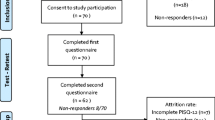Abstract
To develop a simple, valid, reliable questionnaire to assess the severity of symptoms and their impact on the quality of life in women with urogenital prolapse. Women recruited from gynaecology outpatient clinics were asked to complete a prolapse quality of life questionnaire (P-QOL) before their hospital visit. At the time of the visit, they were examined supine using the International Continence Society (ICS) prolapse score (POP-Q). A second P-QOL was posted and completed by patients 2 weeks later. The validity was assessed by measuring levels of missing data, comparing symptom scores between affected and asymptomatic women and comparing symptom scores with objective prolapse stages. The internal reliability was assessed by measuring the Cronbach alpha coefficient; 155 symptomatic and 80 asymptomatic women were studied. Severity according to P-QOL strongly correlated with the vaginal examination findings (p<0.01, rho>0.5). The total scores for each P-QOL domain were significantly different between symptomatic and asymptomatic women (p<0.001). All items achieved a Cronbach alpha greater than 0.80 showing good inter-rater reliability. The test-retest reliability confirmed a highly significant correlation between the total scores for each domain. A P-QOL questionnaire for English-speaking patients has been developed which is reliable and valid.
Similar content being viewed by others
References
Samuelsson EC, Arne Victor FT, Tibblin G, Svardsudd KF (1999) Signs of genital prolapse in a Swedish population of women 20 to 59 years of age and possible related factors. Am J Obstet Gynecol 180:299–305
Progetto Menopausa Italia Study Group (2000) Risk factors for genital prolapse in non-hysterectomized women around menopause. Results from a large cross-sectional study in menopausal clinics in Italy. Eur J Obstet Gynecol Reprod Biol 93:135–140
Bump RC (1993) Racial comparisons and contrasts in urinary incontinence and pelvic organ prolapse. Obstet Gynecol 81:421–425
Graham CA, Mallett VT (2001). Race as a predictor of urinary incontinence and pelvic organ prolapse. Am J Obstet Gynecol 185:116–120
Nichols DH (1978). Vaginal surgery. Williams & Wilkins, Baltimore
Brown JS, Waetjen LE, Subak LL, Thom DH, Van den Eeden S, Vittinghoff E (2002) Pelvic organ prolapse surgery in the United States, 1997. Am J Obstet Gynecol 186:712–716
Swift SE, Tate SB, Nicholas J (2003) Correlation of symptoms with degree of pelvic organ support in a general population of women: what is pelvic organ prolapse? Am J Obstet Gynecol 189:372–379
Barber MD, Kuchibhatla MN, Pieper CF, Bump RC (2001) Psychometric evaluation of 2 comprehensive condition-specific quality of life instruments for women with pelvic floor disorders. Am J Obstet Gynecol 185:1388–1395
Bump RC, Mattiasson A, Bo K et al (1996) The standardization of terminology of female pelvic organ prolapse and pelvic floor dysfunction. Am J Obstet Gynecol 175:10–17
Nunnally JC (1978). Psychometric theory. McGraw Hill, New York
Carmines E, Zeller R (1979). Reliability and validity assessment: quantitative applications in the social science. Sage, Beverley Hills, California
Beck RP (1983). Pelvic relaxational prolapse. In: Kase NG, Weingold AB (eds) Principles and practice of clinical gynecology. John Wiley & Sons, New York, pp 677–685
Olsen AL, Smith VJ, Bergstrom JO, Colling JC, Clark AL (1997) Epidemiology of surgically managed pelvic organ prolapse and urinary incontinence. Obstet Gynecol 89:501–506
Jackson S, Donovan J, Brookes S, Eckford S, Swithinbank, Abrams P (1996) The Bristol Female Lower Urinary Tract Symptoms Questionnaire: development and psychometric testing. Br J Urol 77:805–812
Kelleher CJ, Cardozo LD, Khullar V, Salvatore S (1997). A new questionnaire to assess the quality of life of urinary incontinent women. Br J Obstet Gynaecol 104:1374–1379
Author information
Authors and Affiliations
Corresponding author
Additional information
Editorial Comment: This paper introduces a new questionnaire to assess the symptoms and quality of life of women with urogenital prolapse. The authors have compared symptomatic woman with asymptomatic women in the evaluation of this new tool. Using well-controlled statistical analysis, a patient-directed diagnostic tool has been formulated. The role of this questionnaire and its applicability to clinical practice is widespread. This gives the clinician the ability to correlate symptom bother with actual physical findings. Additionally, quality of life parameters can be used in the postoperative period to gain insight into patients’ subjective assessment of their surgical outcomes
Appendix
Appendix





Rights and permissions
About this article
Cite this article
Digesu, G.A., Khullar, V., Cardozo, L. et al. P-QOL: a validated questionnaire to assess the symptoms and quality of life of women with urogenital prolapse. Int Urogynecol J 16, 176–181 (2005). https://doi.org/10.1007/s00192-004-1225-x
Received:
Accepted:
Published:
Issue Date:
DOI: https://doi.org/10.1007/s00192-004-1225-x




